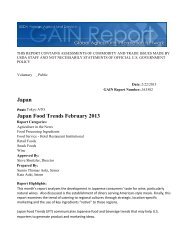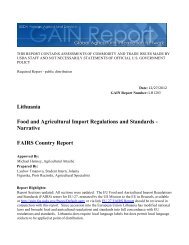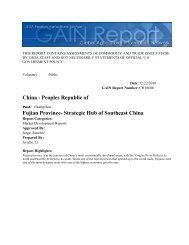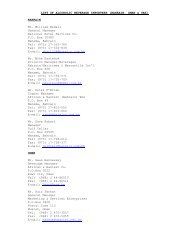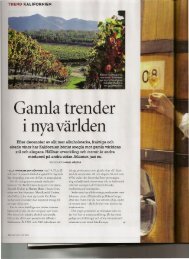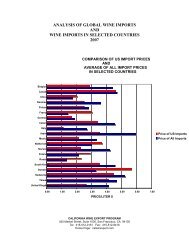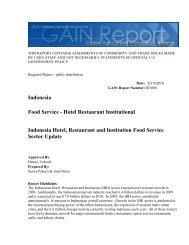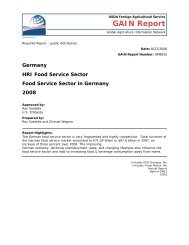Brazil Wine Market Report JBC EMP July 2011 - California Wine ...
Brazil Wine Market Report JBC EMP July 2011 - California Wine ...
Brazil Wine Market Report JBC EMP July 2011 - California Wine ...
You also want an ePaper? Increase the reach of your titles
YUMPU automatically turns print PDFs into web optimized ePapers that Google loves.
III - by the use of cooling;<br />
IV - with the help of ion exchange resins;<br />
V - the use of chemicals, or<br />
VI - a microbiological process.<br />
44<br />
<strong>Brazil</strong>ian <strong>Wine</strong> <strong>Market</strong> <strong>Report</strong><br />
§ 2 The acidified wine must contain at least one gram per liter of tartaric acid.<br />
Article 40. Clarification is the use of chemical and physical processes aimed at making wine<br />
clear and stable.<br />
§ 1 Collage is the addition of chemicals to wine in order to:<br />
I - complete spontaneous clarification;<br />
II - red wines soften eliminating part of its tannins and polyphenols, and<br />
III - to clarify cloudy wines.<br />
§ 2 Filtration involves passing the wine through appropriate filters or substrates,<br />
such as land boards and membranes to remove particles in suspension in order to<br />
provide clarity and stability organic wine to the elimination of microorganisms.<br />
I - the board should be made of suitable material, and<br />
II - the membrane must have a porosity less than two tenths of a micron and<br />
equal to or<br />
less than sixty-five hundredths.<br />
§ 3 is to transfer racking wine from one container to another to allow the separation<br />
of the liquid and solid deposits, therefore:<br />
I - separate the wine from the sludge and deposits from adding clarifiers;<br />
II - to separate the wine at the end of microorganisms or malolactic<br />
fermentation, or amendments caused by bacteria or yeast;<br />
III - to allow the implementation of all winemaking operations, processing and<br />
transport of wines, and<br />
IV - allow tartaric stabilization and separation of tartrate crystals.<br />
§ 4 For the clarification of wine, may still be used substances in order to:<br />
I - coagulation of glue added to the wine;<br />
II - to facilitate the cleaning of new wines by the partial precipitation of<br />
protein substances;<br />
III - to facilitate the bonding;<br />
IV - correct the sensory characteristics of wines from musts altered by fungi<br />
undesirable;<br />
V - remove any contaminants, and<br />
VI - to correct the color of wines.<br />
§ 5 may be used enzymes to aid clarification.<br />
§ 6 is prohibited clarification to correct the color of the wine when the wine that has<br />
led been subjected to the same practice.<br />
Article 41. Enzymatic treatment is to add enzymes to the product, with the aim of:<br />
I - to help reveal the aromatic potential of wine from the precursors from the grape;<br />
II - to facilitate the release of soluble constituents of yeasts;



